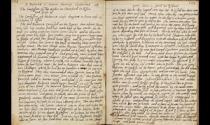A 350-year-old notebook describing the execution of innocent women for ‘consorting with the Devil’ has been published online by The University of Manchester’s John Rylands library as part of the JISC funded Centre for Heritage Imaging and Collection Care (CHICC) project.
The notebook was written by Puritan writer Nehemiah Wallington who describes how a supposed coven of witches lived in the Suffolk village of Manningtree.
Unfortunately for them, Manningtree was also home to the Witchfinder General Matthew Hopkins, notorious for his brutality against women.
In 1645 the Witchfinder General examined one of the suspected witches Elizabeth Clarke for ‘devil’s marks’ like warts or moles.
Under torture, Elizabeth then named other women as witches including her own daughter Rebecca, who later confessed to being a witch.
19 women were eventually hanged, though Rebecca was saved thanks to her confession.
The witchcraft trial is just one of the fascinating episodes contained in Wallington’s notebook, one of only seven remaining out of the 50 he wrote, which documents his attitudes to life, religion and the civil war.
Through the eContent programme, JISC has supported the John Rylands Library in setting up the CHICC project to investigate how the right business models can help them maintain and further develop their digital assets.

